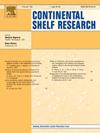Phytoplankton and zooplankton production in the Bonney Coast upwelling, Australia: A coupled physical-biological model investigation
IF 2.2
3区 地球科学
Q2 OCEANOGRAPHY
引用次数: 0
Abstract
The Bonney Coast Upwelling is a prominent seasonal coastal upwelling region that develops during November–April on Australia's southeastern continental shelf. This study couples a three-dimensional hydrodynamic model with a nitrogen-phytoplankton-zooplankton-detritus (NPZD) model to explore the plankton dynamics during the upwelling season. Findings suggest that, while the physical response to upwelling-favorable winds occurs rapidly on a timescale of 5–10 days, phytoplankton blooms develop only slowly on time scales of ∼30–60 days. To this end, the region of high zooplankton levels is predicted to form slowly on timescales of 2–3 months. As expected, the zooplankton maximum develops downstream from the upwelling center in the shallow waters of an adjacent bay (i.e., Long Bay) over an alongshore distance of 200–300 km. Unexpectedly, high zooplankton levels also develop on the inner shelf adjacent to the upwelling plume on spatial scales of 20–30 km, mainly due to the onshore transport of phytoplankton via lateral turbulent diffusion. Overall, remineralization by detritus contributes significantly (>50%) as nitrogen source to the photosynthetic phytoplankton production on the continental shelf.
澳大利亚邦尼海岸上升流中浮游植物和浮游动物的生产:一个耦合的物理-生物模型研究
邦尼海岸上升流是一个突出的季节性沿海上升流区域,在11月至4月期间在澳大利亚东南大陆架上发展。本研究将三维水动力学模型与氮-浮游植物-浮游动物-碎屑(NPZD)模型相结合,探讨了浮游生物在上升流季节的动态变化。研究结果表明,虽然对有利于上升流的风的物理反应在5-10天的时间尺度上迅速发生,但浮游植物华花在30-60天的时间尺度上发展缓慢。为此,预计浮游动物高水平区域将在2-3个月的时间尺度上缓慢形成。正如预期的那样,浮游动物最大限度地从上升流中心下游发育在邻近海湾(即长湾)的浅水区,沿岸距离为200-300公里。出乎意料的是,在20-30 km的空间尺度上,靠近上升流羽的内陆架上也出现了较高的浮游动物水平,这主要是由于浮游植物通过横向湍流扩散在岸上运输。总体而言,碎屑的再矿化作用对大陆架浮游植物光合作用的氮源贡献显著(>50%)。
本文章由计算机程序翻译,如有差异,请以英文原文为准。
求助全文
约1分钟内获得全文
求助全文
来源期刊

Continental Shelf Research
地学-海洋学
CiteScore
4.30
自引率
4.30%
发文量
136
审稿时长
6.1 months
期刊介绍:
Continental Shelf Research publishes articles dealing with the biological, chemical, geological and physical oceanography of the shallow marine environment, from coastal and estuarine waters out to the shelf break. The continental shelf is a critical environment within the land-ocean continuum, and many processes, functions and problems in the continental shelf are driven by terrestrial inputs transported through the rivers and estuaries to the coastal and continental shelf areas. Manuscripts that deal with these topics must make a clear link to the continental shelf. Examples of research areas include:
Physical sedimentology and geomorphology
Geochemistry of the coastal ocean (inorganic and organic)
Marine environment and anthropogenic effects
Interaction of physical dynamics with natural and manmade shoreline features
Benthic, phytoplankton and zooplankton ecology
Coastal water and sediment quality, and ecosystem health
Benthic-pelagic coupling (physical and biogeochemical)
Interactions between physical dynamics (waves, currents, mixing, etc.) and biogeochemical cycles
Estuarine, coastal and shelf sea modelling and process studies.
 求助内容:
求助内容: 应助结果提醒方式:
应助结果提醒方式:


